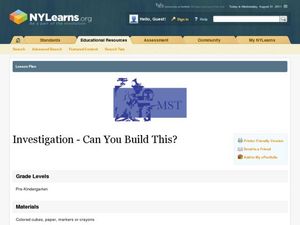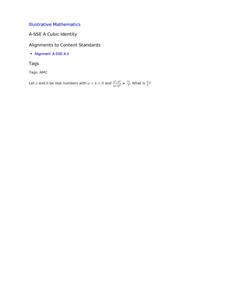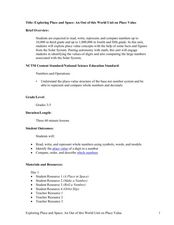Curated OER
Sums and Difference of Cubes
Learners factor polynomials using the sum and difference of cubes. They also learn connections between the graph and expression.
Curated OER
Connecting Cube Structures (C)
In this connecting cube structures practice instructional activity, students solve 4 problems that require them to use connecting cubes to build the pictured structures.
Noyce Foundation
Cutting a Cube
Teach the ins and outs of the cube! A series of five K–12 level activities explore the make-up of the cube. The beginning lessons focus on the vocabulary related to the cube. Later lessons explore the possible nets that describe a cube....
Curated OER
Connecting cube Structures
In this cube structure worksheet, students use connecting cubes to build structures shown in pictures. One picture is shown from 2 different angles.
Curated OER
Connecting Cube Structures
In this cube worksheet, students use connecting cubes to build structures pictured on worksheet; bottom structure is shown from 2 different angles, 4 structures total.
Curated OER
Connecting Cube Structures [E]
In this cube worksheet, students use connecting cubes to build structures pictured on the worksheet, 3 structures total. The bottom structure is shown from 2 different angles.
Curated OER
Investigation--Can You Build This?
Early learners explore shapes using colored blocks. They first get some hands-on time with the blocks and then look at beginning math concepts regarding spatial relationships. They work with a partner to build a 6-8 block tower with...
EngageNY
Linear Transformations Applied to Cubes
What do you get when you combine a matrix and a cube? Well that depends on the matrix! Pupils use online software to graph various transformations of a cube. Ultimately, they are able to describe the matrix that is responsible for a...
Noyce Foundation
Cubism
If cubism were a religion, would you follow it? Lower-level tasks focus primarily on counting the number cubes in a structure and relating the number to surface area. As learners progress to higher-level tasks, isometric drawings and...
Curated OER
Solving Polynomial Equations
This worksheet and tutorial explores solving more complex polynomials by graphing each side separately and finding the point of intersection, identifying the sum and differences of cubes, and solving higher degree polynomials by using...
Curated OER
What's My Structure
Fourth graders use the language of mathematics to describe in words a 3-D structure created with one-inch cube. They interpret a written description of a 3-D structure and re-create it with one-inch cubes. Students use Quick Time...
Curated OER
New Boxes From Old
Students find the volume and surface area of a rectangular box (e.g., a cereal box), and then figure out how to convert that box into a new, cubical box having the same volume as the original. As they construct the new, cube-shaped box...
EngageNY
Mastering Factoring
Math class is full of drama—there are so many problems to work out! Pupils work out factoring problems. They use quadratic methods of factoring higher degree polynomials, in addition to factoring the sum and difference of two cubes.
Exploratorium
Building Three-Dimensional Structures
Are you looking for a good 3-D geometry lesson that includes hands-on activities for your middle schoolers? Look no further than this one! Pupils use centimeter grid paper embedded in the plan, along with detailed construction...
Teach Engineering
Connect the Dots: Isometric Drawing and Coded Plans
Individuals discover how to draw cubes on triangle-dot paper. They use cubes to build structures and draw corresponding isometric drawings on dot paper in the second lesson of the series of five. The activity also introduces the concept...
Illustrative Mathematics
An Integer Identity
Challenge algebra learners to use the difference of cubes to solve this problem. Once your charges have taken out the factor (a - b), combined the like terms and set them equal to zero, the problem becomes a factorable quadratic...
Curated OER
Cubes Everywhere
Students use cubes to construct and visualize two-and three-dimensional shapes to develop spatial thinking and review basic geometric principles through real-life applications. They are given the opportunity to build and build and take...
Curated OER
Isometric Drawings 2
In this isometric drawings learning exercise, students analyze the drawing of the structure that can be made with cube blocks. Students use cube blocks to make the structure and then draw three different views on the dotted grid.
Curated OER
Junior Architects of America
Students create entries for the Architects of America contest, including a model of a futuristic structure, blueprints, a list of all plane and solid shapes in the structure, a persuasive argument paper that describes why the structure...
Curated OER
Various Volumes
In this volume worksheet, students create different sized cubes and compare the sizes by pouring sand from one cube into another. Students follow 4 directions and reflect on their findings.
Illustrative Mathematics
1.OA, NBT, The Very Hungry Caterpillar
First graders are exposed to addition of three whole numbers in a math activity centered around Eric Carle's, The Very Hungry Caterpillar. As the teacher reads, young mathematicians use counters and ten-frames to symbolize the number of...
Curated OER
Exploring Place and Space
Students explore number values by completing mathematical worksheets in class. In this decimals lesson, students identify the different place values a number has and the use of decimals to represent a fraction of a number. Students...
Teach Engineering
Seeing All Sides: Orthographic Drawing
How can your draw three-dimensional figures on paper? The lesson shows pupils how to draw orthographic projections of three-dimensional figures composed of cubes. After viewing a PowerPoint presentation, they practice this skill with...
Teach Engineering
Let's Take a Spin: One-Axis Rotation
Investigate the effect of one-axis rotations on geometric figures. Scholars learn to use snap cubes and the right-hand rule to draw figures after rotations about the x-, y-, or z-axes. They try their hands at examples created by the...







![Connecting Cube Structures [E] Worksheet Connecting Cube Structures [E] Worksheet](http://content.lessonplanet.com/resources/thumbnails/216860/large/cgrmlwnvbnzlcnqymdezmdmzms0xmta4ny00mtnynhauanbn.jpg?1414306938)

















